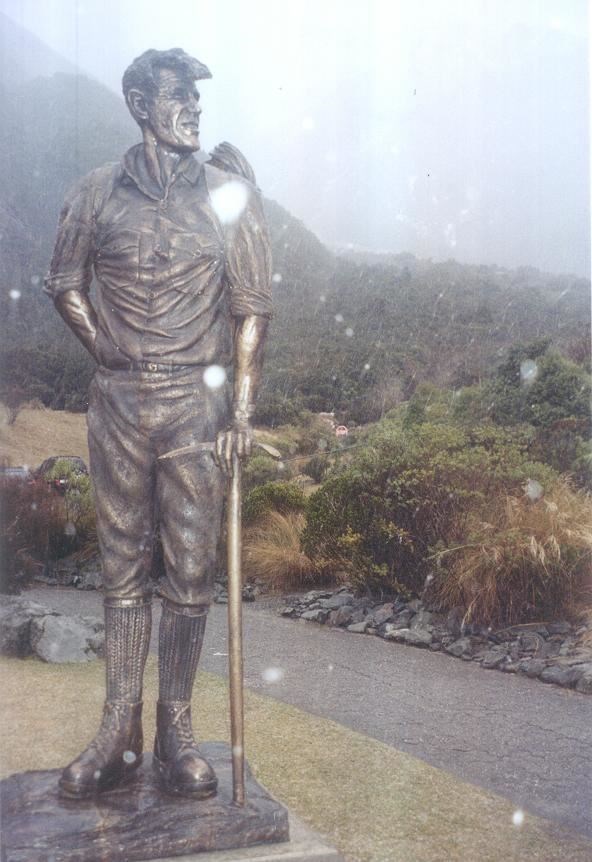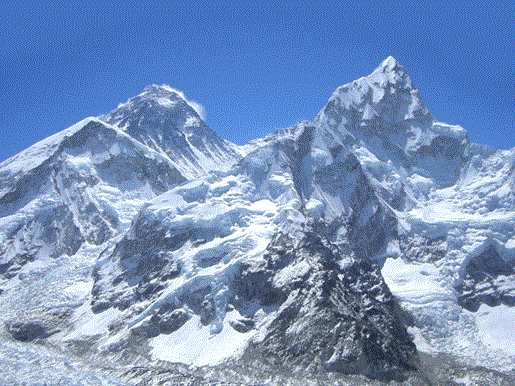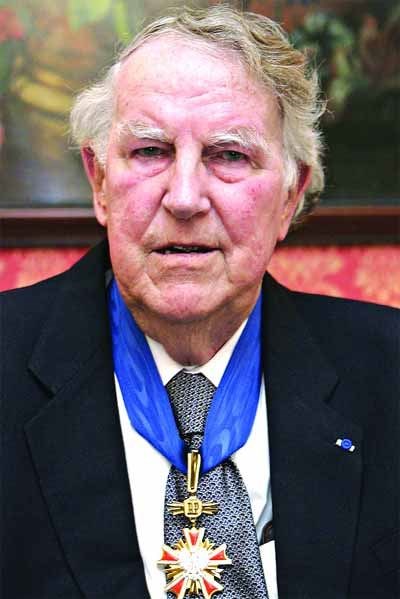 |
| Sir Edmund Hillary's statue at the Hermitage |
There are many Names in history that become famous for great heroism, and many for dedication to a great cause. What makes the New Zealander Sir Edmund Hillary stand out is that, from humble beginnings he as a young man dedicated himself to heroic physical feats, then later in life he shifted his focus to the humanitarian needs of the Nepalese, a people he came to love and admire. This essay describes the extraordinary character of this hero, a hero who in many ways personifies the spirit of adventure that many New Zealanders strive to achieve. While it is difficult to compare Sir Edmund to Benjamin Franklin, one was scientist, one was an explorer, both national heroes adorn the national currency and both heroes inspired the nations they belonged to. Sir Edmund is an inspiration to me because his heroism was exceeded only by his humility and this trait is very important to me because without humility the world has no heroes.
Edmund Hillary was born in New Zealand in 1919 and began working life at a very early age as an apiarist in New Zealand in the 1940s, in fact even after many of his climbing and beekeeping feats he was quite content to return to the farm and make a living in the humble art of beekeeping. This shows he was not motivated by the prospect of financial gain. In his autobiography Edmund refers to the hard physical work of beekeeping, apart from climbing mountains it seems it was this physical exertion that gave him the physical fitness to climb. Edmund always had a strong sense of family and the beekeeping work was always conducted as part of the family business with his father and his brother. He did attempt to interest his brother in mountain climbing but his brother only accompanied him once.
World War Two was coming to an end when Edmund started serving his country. Initially he enlisted but his father pressed him to stay and help with the business, later he was conscripted and served in the Pacific Theater. As this was quite late in the war he did not see active combat. The most danger he saw was when a group of friends decided to fight crocodiles and Edmund dropped his service weapon and then spent several dangerous hours swimming in crocodile infested waters looking for his weapon. While he was unsuccessful in finding his weapon this fearless attitude possibly helped him later in life. His dedicated recovery efforts did mitigate the reprimand for losing his weapon.
 |
| Mount Everest |
Mount Everest is over 29,000 feet high and it was not known if a human could even survive at this extraordinary altitude. In 1953 a well funded British expedition was put together and as New Zealand is part of the Commonwealth, Edmund was asked to join the expedition. The expedition was a huge undertaking with hundreds of native porters, called sherpas from Nepal, and many stages of climbing the mountain. There were other expeditions that had tried and failed before and this serious attempt was in some ways a matter of British honor. It is a strange twist of fate that Edmund was given the option to as Hillary said himself “knocking off Everest”, Edmund chose to use experimental oxygen breathers that mixed the air with oxygen and that combined with his own physical ability enabled him and Sherpa Tenzing to make the final climb to the top. On this expedition several others had already tried and none had made it to the top.
 |
| Sir Edmund Hillary, the later stages |
Just as the first man on the moon, Neil Armstrong, received huge recognition, so too only the very first to climb Everest would have that same recognition. Recognizing this, Edmund and Sherpa Tenzing decided to keep a secret and not tell anybody who was first to the top, a secret they kept for many decades. This unusual and humble act gave great credit to the Nepalese people. Later in life Edmund would dedicate himself and his family to helping these people.
After climbing the mountain on the eve of Queen Elizabeth’s coronation it was Queen Elizabeth herself who knighted Edmund. He was from then on known as Sir Edmund, a title that he preferred people not to use. It was also interesting to note that on traveling to England and telling the story of breathing without oxygen at 29,000 feet doctors tested him extensively, eventually deciding that his feat was in their opinion scientifically impossible. There is little doubt that the fearless force of will that drove him to swim with crocodiles carried him through this dangerous moment.
The Nepalese people while tremendously tough and adjusted to the extraordinary conditions of the Himalayas lacked basic needs such as schools and medicine. As stated by Brook Allen Hall in Science in its Times in 2001, “Along with his exciting and interesting life Hillary took the time to form a Himalayan Trust Fund that funds humanitarian work amongst the sherpas, building clinics, hospitals, and numerous schools.” Sir Edmund’s children are an active part of this trust fund. Sir Edmund had four children, his youngest daughter and his wife were tragically killed in a plane crash just outside of Kathmandu. This devastating loss did not stop him in his crusade to help the Nepalese people. Sir Edmund did remarry but did not have any more children.
Sir Edmund passed away at the age of 88 in 2008 in New Zealand, his passing bought New Zealand to a standstill and he will always be remembered as a great hero with a huge heart and fearless determination to succeed. I have enjoyed researching this heroic man and I hope this short essay will help inspire others to humble heroism.
Academy of achivement, . "From Beekeeper to World Explorer." Sir Edmund Hillary Biography (2008): 1. Web. 4 Jan 2011
Hall, Brook Ellen. "Sir Edmund Percival Hillary." Science and Its Times. Ed. Neil Schlager and Josh Lauer. Vol. 7: 1950 to Present. Detroit: Gale, 2001. 52-53. Gale Virtual Reference Library. Web. 1 Jan. 2011
Hillary, Edmund. Nothing Venture Nothing Win. 2nd UK. England: Hodder & Stoughton General Division, 1975. Print.
Karam, P. Andrew. "Sir Edmund Hillary Leads the First Team to Reach the Summit of Mt. Everest." Science and Its Times. Ed. Neil Schlager and Josh Lauer. Vol. 7: 1950 to Present. Detroit: Gale, 2001. 6-8. Gale Virtual Reference Library. Web. 1 Jan. 2011.
Page created on 1/21/2011 12:00:00 AM
Last edited 9/7/2018 11:29:40 PM
